|
|
|
Sort Order |
|
|
|
Items / Page
|
|
|
|
|
|
|
| Srl | Item |
| 1 |
ID:
126781
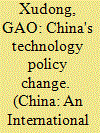

|
|
|
|
|
| Publication |
2013.
|
| Summary/Abstract |
The Chinese central govemment held the 4th National Conference on Science and Technology on 9 January 2006. At this important meeting. President Hu jintao and Premier Wen Jiabao made their speeches and announced the decision to develop China into an innovative country. On the same day. the State Council announced and issued the "National Guideline on Medium and Long-term Program for Science and Tech-
nology Development (2006-2020)'. According to the Guideline. by 2020. China': entire investment in resarch and development (R&D) is expected to ruch 2.5 per cent of the country's gross domestic product. while science and technology will contribute to about 60 per cent of the country's economic development.'
|
|
|
|
|
|
|
|
|
|
|
|
|
|
|
|
| 2 |
ID:
126780
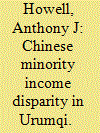

|
|
|
|
|
| Publication |
2013.
|
| Summary/Abstract |
Ethnic tensions between Uyghur and Han Chinese culminated in 2009 with the Urumqi riots, one of the bloodiest conflicts in Xinjiang's modern history, which left more than 200 people dead and another 1,700 injured. Following the 2009 Urumqi Riots, Chinese policy towards Xinjiang underwent a major shift, breaking away from its previous "gradualist" approach to one of economic development. In its place, China implemented policies meant to spur "leapfrog development" in Xinjiang. These new economic policies are likely to bring about rapid growth to the region; however, the question remains whether this growth will be equitably transferred amongst all ethnic groups and regions within Xinjiang.
|
|
|
|
|
|
|
|
|
|
|
|
|
|
|
|
| 3 |
ID:
126785
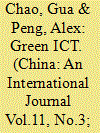

|
|
|
|
|
| Publication |
2013.
|
| Summary/Abstract |
Under the national strategy of a "let informatisation drive industrialisation, and let industrialisation promote informatisation", China's electronic information industry has achieved continuous and dramatic development during the last three decades. It has now become one of the most essential pillar industries for China's national economy. However, severe pollution issues and environmental challenges emerge at different stages throughout the lifecycle of Information and Communication Technology (ICT) products, from their design, development, and manufacturing to use and to disposal. Evidence shows that much effort has been put to increase industrial profit margin, improve indigenous innovation, and overcome the negative effects of the 2008 financial crisis on China's electronic information industry. Nevertheless, environmental issues have traditionally received less attention from industrial manufacturers and users of ICT products (e.g. CEOs, managers and employees of companies, and individual citizens). China is still in its infant stage in building up a green electronic information industry. This paper discusses and highlights the importance and impacts of current environmental challenges faced by the electronic information industry, as well as to propose the implementation of Green ICT as a key strategy to ensure environmental-friendly use of ICT equipments and thus maintain sustainable development of this industry in the long term.
|
|
|
|
|
|
|
|
|
|
|
|
|
|
|
|
| 4 |
ID:
126786
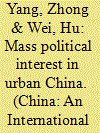

|
|
|
|
|
| Publication |
2013.
|
| Summary/Abstract |
Political and economic developments in China seem to continue to defy the con- ventional wisdom that economic growth fosters The Chinese communist regime has successfully survived the worldwide wave of democratization. including the recent democratic changes in the Arab world. What sustains the stability of the Chinese political regime appears to be the country's rapid economic growth over the past three decades as it catapults China to becoming the second-largest economy in the world. In the reform era. the communist Party of China (CFC) sumwliilly turned a political system of 'politics taka command" during the Cultural Revolution into a system of 'economics rakes command". Deng Xiaoping once famously said that 'economic development is the real hard truth' (FISLUN SIN' YINGDAOLI). implying that so long as the economy performs well. the CPC regime will remain stable. especially since the primary concern of the Chinese people is their personal economic conditions. Indeed. the political legitimaqr of the CPC today is said to be largely built upon.
|
|
|
|
|
|
|
|
|
|
|
|
|
|
|
|
| 5 |
ID:
126784


|
|
|
|
|
| Publication |
2013.
|
| Summary/Abstract |
China is the world's largest non-gcnetically modi?ed (NGM) soybean producer and importer' in china': domestic market. Soybeans an: a very in?uential agricultural commodity used an a staple for human consumption. An important animal feed ingredient and a key material for the production of human consumable oil. The northeastern provinces of Heilongjiang, jilin. Liaoning and the inner Mongolia compotes: china'; largest production box. Supplying 60 % of domestic soybeans in china
|
|
|
|
|
|
|
|
|
|
|
|
|
|
|
|
| 6 |
ID:
126791


|
|
|
|
|
| Publication |
2013.
|
| Summary/Abstract |
Contract farming has emerged between processors and farmers : in China since the 1990:. 'Due Chinese government encourages partnership between leading enterprises (LE). the big agriculture commodity processing firms and farmers who ate producers of such commodities. With the goal of incusing airmen' income and improving agricultural productivity through agriculture industrialization. the government has helped to establish and promote contact farming systems through a mutually bene?t- in mechanism between LE: and farmers.
|
|
|
|
|
|
|
|
|
|
|
|
|
|
|
|
| 7 |
ID:
126793


|
|
|
|
|
| Publication |
2013.
|
| Summary/Abstract |
Bandwagoinng with China against the United States and simultaneously covertly trying to testation China have been the dominant motives of Russia's Asian in Northeast and Southeast Asia. Throughout the 2000s. due to this dual-smelt policy. Russia had resigned itself to its growing economic dependence on China and its role as an energy source China. Between 2009and20lz. Russia madeaconseiouselibtt to portray itself as an Asian played. However. Russia's failure to develop the Russian Fat East (RFE) has fumed it to "turn to China for help". and this has allowed China to begin building a new economic and security otdet in Asia at Russia's expense. The nature and din.-action of the Russo-Chinese "strategic partnership" under Chinese President Xi jinxing and Russian President Vladimir Putin is aping becoming a subject of intense debate. The mayor assumption of this atticle is that it is unliltely that Russia would simply acquiesce in subonlination to China without tufting to situations with negativity.
|
|
|
|
|
|
|
|
|
|
|
|
|
|
|
|
| 8 |
ID:
126789
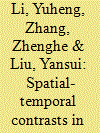

|
|
|
|
|
| Publication |
2013.
|
| Summary/Abstract |
For a long period following the establishment of People's Republic of China in 1949, urban and rural areas were treated separately and differently. Since 1978, China has experienced over three decades of rapid economic growth, with annual growth rates of over 9 per cent. However, despite this "economic miracle", the country has also witnessed ever-enlarging urban-rural inequalities across a range of indicators such as income, education, medical care, provision of infrastructure and social insurance. For example, while the per capita urban household income increased from 343 yuan in 1978 to 13,041 yuan in 2007, over the same period the per capita rural household income increased from 134 yuan to only 3,998 yuan. (1) A cluster of studies that investigated urban-rural inequalities in China have attributed the inequalities to factors such as a dualistic urban-rural structure, (2) urban-biased development strategy, (3,4) market forces (5) and taxation. (6) Urban-biased policies and related measures like the household registration system (hukou) were initially formulated on the basis of the typical socio-economic conditions in China in the period after 1949. These policies and measures have, however, intentionally diverted resources (capital, labour and materials) from rural to urban areas, and induced greater urban-rural inequality in China.
|
|
|
|
|
|
|
|
|
|
|
|
|
|
|
|
|
|
|
|
|